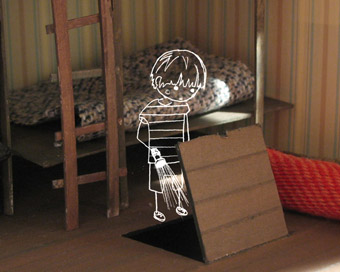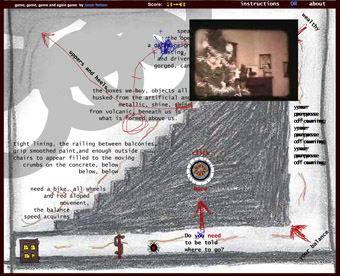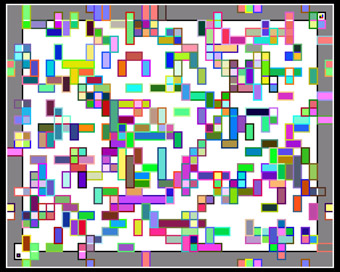wired 4 games: artful computer gaming
bernadette ashley

Ruckblende (‘Flashback’), Nils Deneke
THE COMBINED INSIGHTS OF A HUMAN-COMPUTER INTERACTION DESIGN RESEARCHER, A SOUND DESIGNER, AND A CYBER POET MADE FOR A LIVELY, IF SOMETIMES CONTRADICTORY, DISCOURSE AT THE RECENT ART U GAME FORUM IN TOWNSVILLE.
Earnest, passionate and irreverent respectively, experts Nicola Bidwell, Tom Ellard and Jason Nelson come at game design from three wildly differing angles. The forum complemented Pinnacles Gallery’s Wired 4 Games, an exhibition of eight award-winning, independent, online computer games from around the world. Curated by Anthony Edwards, the interactive show is a concrete demonstration of how games design is being more widely recognised as intersecting with art, while the forum revealed the broad draw of this relatively new genre, with few boundaries apart from cost and computer memory limitations.
Nicola Bidwell, senior lecturer in IT at James Cook University (Cairns), acknowledged that her phenomenological research and experiments into how people experience, feel, remember and navigate in natural environments creates the potential for “designing games not to replicate the outdoor experience, but to get at that feeling…games to take the self into a different space.”
“While some [existing] game environments are beautiful”, Bidwell said, “the narrative is a difficulty—you have to keep shooting people to progress through that world. Traditional games use devices such as shortcuts and teleportation, adding to the time challenge. They are not used like real places for memories, stories, enjoyment and the range of emotions which make a place a specific place for you. There are few opportunities to placemake; no footprints, no path abrasion, no scars from your fires, no real physical indication of meaning, and this interrupts the flow of any sense of belonging.”
Bidwell’s research underpins her belief that nature and landscape can represent a protagonist, make a player work hard, pay attention and make memories, draw them through and reward them with momentary pleasures like the light filtering through trees.
“Natural views, trees and water are notoriously difficult to animate without costing too much computer memory, so artists circumvent this by creating the sensation in the eye that views the subject, rather than recreating the subject.” Bidwell explains that when this is done successfully it can, like Impressionism, evoke sensations without needing high fidelity focus on the subject, as in Cloud, one of the more meditative games in the exhibition.
Mixed reality gaming is another application Bidwell’s research points to. “Why not play inside a video” she asked, “and allow the player to become author and artist?”
Tom Ellard of CoFA (College of Fine Arts, UNSW) told the forum that he focused on sound design because “You can spend four years at uni and 200 years in a gulag in Siberia [studying game design] and still not be able to code Tetris.” Animated by his subject, Ellard packed the history of sound in games design into a memorable hour, impressing on the forum that the audio component is 50% of the experience in hybrid arts, but is generally underfunded and usually left to the last minute.
Covering everything from Space Invaders (the first computer game with a continuous soundtrack) to the dialogue parsing in Halo, Ellard illustrated how sound focuses a player’s attention, frames scenes, anticipates action, provides emotional guidance and extends game worlds. “Sound can be a cheap way to enlarge a gameworld in terms of processing power and design time”, Ellard explained. “If the budget is $5, one sound like birdsong can imply a whole gameworld outside a virtual room.”

Jason Nelson, Game, game and again game
Jason Nelson, a cyber poet who originally hails from Oklahoma and now teaches Net Art and Electronic Literature at Griffith University on the Gold Coast, good humouredly repudiated Bidwell and Ellard’s input with his audacious lack of consideration for gaming conventions of any kind. “Made on a lark”, one of his online games has received over eight million hits. “But, he added self-deprecatingly, “cats throwing up can get two million hits on YouTube.”
Nelson described his works as “anti-games…messy, screwed-up and strange…digital poetics with interactive narratives…some confusing type of hell built from messy lines, originally meant to overload your computer so you’d have to back out.” He builds using “played to death platform engines [which] form a bridge into artwork because even if people have never been in a gallery, or don’t understand the content, they’ll still play around with it.”
Nelson encouraged would-be game designers, artists and writers at the forum to “think as imaginatively as possible…collect interfaces…and make your own games not from your coding skills, but from your creative skills.” He has used hand-drawn graphics, Flash for music, Fruity Loops for samples, snatches of advertising soundtracks and Super 8 films from his childhood, even borrowing poker machine technology to create games which randomly predict comically dark death scenarios for the player, and a Christmas disaster generator.
Game, game and again game (2007, see www.realtimearts.net/portal), Nelson’s award winner, was the Australian inclusion in Wired 4 Games, alongside games from Canada, Germany, France and the USA. “C’mon and meet your maker”, intones Nelson’s game every time you die (but don’t die) in this colourful and cacophonous reflection on belief systems, inspired by “Mormon pamphlets in laundromats.” With levels labelled fundamentalist, Buddhist and real estate, among many, the game observes game conventions just enough so that “people will follow if told to ‘go there’ or ‘click this’”, but there’s no point scoring in the traditional sense—you may be rewarded with a snatch of text from The Book of Swordfish instead.
The game is an addictive sensory assault when played online at Nelson’s website www.secrettechnology.com, and projected on the wall at Pinnacles the disorienting effect was magnified, but still magnetic.
In complete contrast to Nelson’s busy screens, Rod Humble’s (USA) Stars Over Half Moon Bay is mesmerising, with slow and restful duotone minimalist graphics and a quiet piano and steel guitar soundtrack by Critical Monkey. The only effort required is some languid scrolling to collect stars and create constellations in a virtual equivalent of star gazing.
Ruckblende (‘Flashback’) by German Nils Deneken has a fairytale quality in its cutout forest, overlaid at intervals with little sketched people, objects and arrows suggesting clues to further stories. As the player navigates through, small events occur, but it appears there’s no particular goal to the game. It had a slightly claustrophobic and sinister feel to me, as though something Grimm was yet to occur.

Mondrian Provoked, Jim McGinley
Mondrian Provoked, created by Jim McGinley (Canada), has increasingly difficult mazes of moving graphics—you are trapped in a Mondrian painting. If the player manages to navigate the maze without being crushed by a block of colour, the reward is a frenetic dance by the painting’s elements, which I can only liken to the vision disturbances at the onset of a migraine.
The most popular game in the exhibition, in terms of eager players, was Kloonigames’ (USA) Crayon Physics Deluxe, which is also fairly conventional in terms of gameplay levels and rewards. It faithfully replicates the laws of physics and applies them to the crayon objects the player creates using a mouse (or stylus on tablet), setting off chains of responses in real time. The game is completely engaging, and elicited the most uninhibited verbal responses (bursts of laughter and howls of frustration) of any game in the exhibition.
Pinnacles, a purpose-built gallery at Townsville’s Riverway complex, is not large but accommodates new media exhibitions well. For Wired 4 Games a low-light ambience was created by deep purple-blue walls with rough edged white patches left as screens for the game projections. Plinths contained the necessary keyboards, mice and headphones (in some cases), and light- and sound-spill was minimal and not distracting. The labelling and instructions were adequate, and an attendant was available to provide guidance if needed, and to troubleshoot the occasional technical glitches. All of the games are accessible online. Most are free, but be warned that some are big downloads due to the complex graphics.
Wired 4 Games, curator Anthony Edwards, Feb 7-March 15; Art U Game Forum, Pinnacles Gallery, Townsville, Feb 28
Rod Humble, Stars Over Half Moon Bay, www.rodvik.com/rodgames/
Nils Deneken, Ruckblende
http://indygamer.blogspot.com/2007/12/new-rckblende-mirror.html
Jim McGinley, Mondrian Provoked, www.bigpants.ca/mondrianprovoked/
Kloonigames, Crayon Physics Deluxe, www.kloonigames.com/crayon/
RealTime issue #90 April-May 2009 pg. 31






